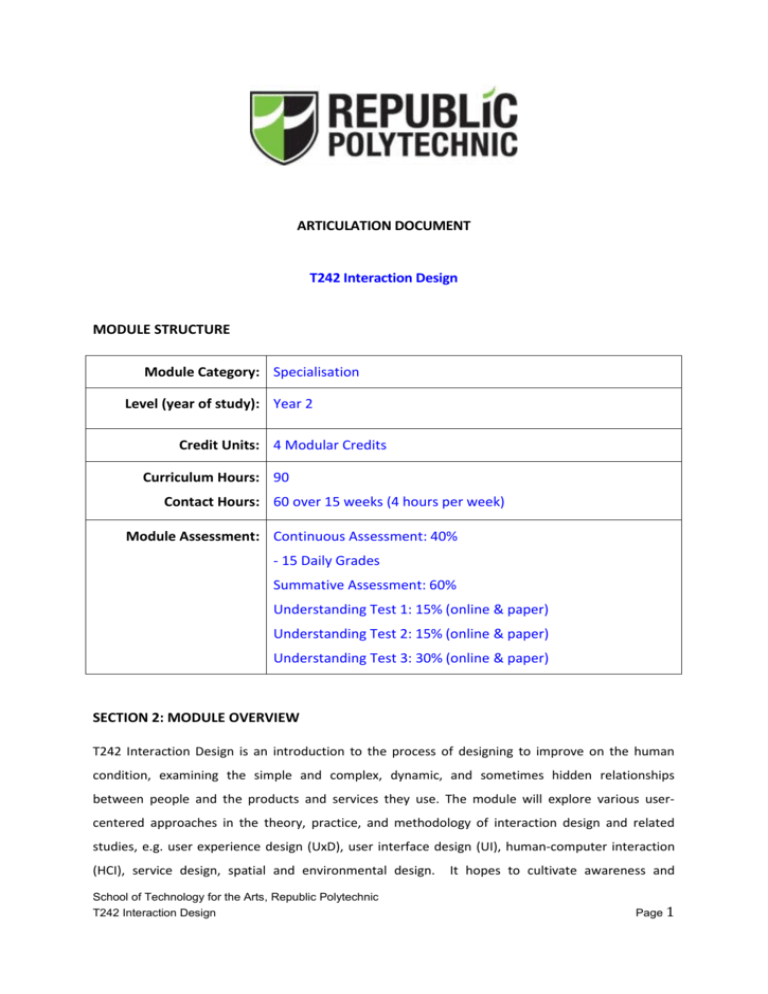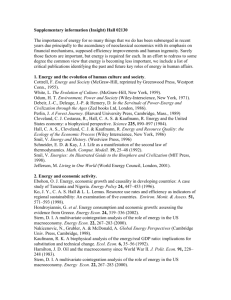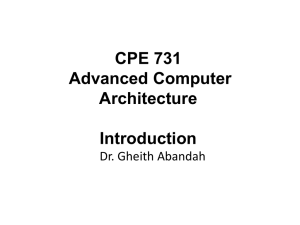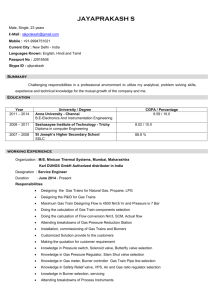ARTICULATION DOCUMENT T242 Interaction Design MODULE
advertisement

ARTICULATION DOCUMENT T242 Interaction Design MODULE STRUCTURE Module Category: Specialisation Level (year of study): Year 2 Credit Units: 4 Modular Credits Curriculum Hours: 90 Contact Hours: 60 over 15 weeks (4 hours per week) Module Assessment: Continuous Assessment: 40% - 15 Daily Grades Summative Assessment: 60% Understanding Test 1: 15% (online & paper) Understanding Test 2: 15% (online & paper) Understanding Test 3: 30% (online & paper) SECTION 2: MODULE OVERVIEW T242 Interaction Design is an introduction to the process of designing to improve on the human condition, examining the simple and complex, dynamic, and sometimes hidden relationships between people and the products and services they use. The module will explore various user‐ centered approaches in the theory, practice, and methodology of interaction design and related studies, e.g. user experience design (UxD), user interface design (UI), human‐computer interaction (HCI), service design, spatial and environmental design. School of Technology for the Arts, Republic Polytechnic T242 Interaction Design It hopes to cultivate awareness and Page 1 understanding of user experiences, through analyses of individual / group needs and wants, balanced against industry / business‐oriented goals, ecological issues, and the technical / technological capabilities of various design disciplines. MODULE OUTCOMES AND LEARNING OUTCOMES In the course of the module, students will acquire a critical understanding of the following principles in interaction design: Interface and interfacing Usability and heuristic evaluation Affordance vis‐a‐vis the user (James J. Gibson, Donald Norman) Ergonomics and ecology / environmental factors Abstraction / Wireframing Proof of concept “Reverse engineering” Enhanced by the iterative process of the pedagogical approach at the institute, students will develop skills and aptitudes in: Doing fieldwork in relation to user research. Evaluating users in various contexts. Sensitivity towards user needs. Analysis of user experiences. Sketching user experiences. Constructing ‘scenarios’ and ‘personas’ to communicate user experiences. Prototyping in relation to usability testing. Concept mapping / modelling. Hypothesis testing. Tracing back of ideas in relation to documentation / documenting. School of Technology for the Arts, Republic Polytechnic T242 Interaction Design Page 2 Allocated time per day Module Coverage Discussions in Study Cluster Spatial Design Classroom Exhibition booth Car parks Service Design Public Transport Music Tangible Design Bags Kitchen appliances Supermarket Trolley Packaging Information Architecture Mobile Interfaces Scanner Interfaces Specific design concepts Existenzmaximum Personification of designed objects Affordance Design ecology & materials sustainability Design Process & Techniques Example: Task analysis, personas, scenarios, scale modeling Total = 15 Problems = 90 hours Resource gathering and team work Skills acquisition and practice 6 6 6 4 4 4 8 8 8 4 4 4 9 12 3 Introduced throughout the day 31 32 35 TEACHING AND LEARNING The module is predominantly delivered via a problem based learning style curriculum. The module is predominantly taught in a classroom and design studio, and also involves field trips and a mini project with a simulated industry client. School of Technology for the Arts, Republic Polytechnic T242 Interaction Design Page 3 LEARNING RESOURCES Antonelli, P. (2008). Design and the elastic mind. New York: Museum of Modern Art. Bennett, A., & Heller, S. (2006). Design studies: Theory and research in graphic design ; [a reader]. New York, NY: Princeton Architectural Press. Berger, C. (2005). Wayfinding: Designing and implementing graphic navigational systems. Crans-Près-Céligny: RotoVision. Bramston, D. (2009). Material thoughts. Lausanne, Switzerland: AVA Academia. Bramston, D. (2009). Idea searching. Lausanne: AVA Academia. Brody, D., & Clark, H. (2009). Design studies: A reader. Oxford: Berg. Buxton, W. (2007). Sketching user experiences: Getting the design right and the right design. Amsterdam: Elsevier/Morgan Kaufmann. Cato, J. (2001). User-centered web design. Harlow [u.a.]: Addison-Wesley. Clarkson, J. (2003). Inclusive design: Design for the whole population. London: Springer. Colin, K. (2003). Extra spatial: Focuses on Ideo's design of interactive environments. San Francisco: Chronicle Books. Cooper, A., Reimann, R., Cronin, D., & Cooper, A. (2007). About face 3: The essentials of interaction design. Indianapolis, IN: Wiley Pub. Dawes, B. (2007). Analog in, digital out: Brendan Dawes on interaction design. Voices that matter. Berkeley, CA: New Riders. Dernie, D. (2006). Exhibition design. New York: W.W. Norton. School of Technology for the Arts, Republic Polytechnic T242 Interaction Design Page 4 Diaper, D., & Stanton, N. A. (2003). The handbook of task analysis for human-computer interaction: [includes CD of the entire book]. Mahwah, NJ [u.a.]: Erlbaum. Dorst, K. (2003). Understanding design. Amsterdam: BIS. Dreyfuss, H. (2003). Designing for people: [the classic of industrial design]. New York, NY: Allworth. Evenden, H. (2007). Moving forward: New directions in transport design. London: V&A. Fuad-Luke, A. (2002). The eco-design handbook: A complete sourcebook for the home and office. London: Thames & Hudson. Gershenfeld, N. A. (2005). Fab: The coming revolution on your desktop--from personal computers to personal fabrication. New York: Basic Books. Gibson, J. J. (1979). The ecological approach to visual perception. Boston: Houghton Mifflin. Hara, K. (2007). Designing design. Baden, Switzerland: Lars Müller. Herriott, L. (2007). The packaging and design templates sourcebook. Mies, Switzerland: RotoVision. Ingram, L. (2005). The everything etiquette book: A modern-day guide to good manners. The everything series. Avon, Mass: Adams Media. Jenson, S. (2002). The simplicity shift: Innovative design tactics in a corporate world. Cambridge, UK: Cambridge University Press. Jordan, P. W. (2002). Designing pleasurable products: An introduction to the new human factors. London: Taylor & Francis. School of Technology for the Arts, Republic Polytechnic T242 Interaction Design Page 5 Karlen, M. (1993). Space planning basics. New York: Van Nostrand Reinhold. Kress, G., & Van Leeuwen, T. (2006). Reading images: The grammar of visual design. New York: Routledge. Kuniavsky, M. (2003). Observing the user experience: A practitioner's guide to user research. Morgan Kaufmann series in interactive technologies. San Francisco, CA: Morgan Kaufmann. Lawson, B. (2004). How designers think: The design process demystified. Oxford: Architectural Press. Lawson, B., & Dorst, K. (2009). Design expertise. Oxford, UK: Architectural Press. Lawson, B. (2004). What designers know. Oxford [England]: Elsevier/Architectural Press. Lidwell, W., Holden, K., & Butler, J. (2003). Universal principles of design. Gloucester, Mass: Rockport. Marzano, S. (1998). Creating value by design. Blaricum: V+K Pub. Maslow, A. H. (1970). Motivation and personality. New York: Harper & Row. McDonough, W., & Braungart, M. (2002). Cradle to cradle: Remaking the way we make things. New York: North Point Press. Moggridge, B. (2007). Designing interactions. Cambridge, Mass: MIT Press. Nair, P., & Fielding, R. (2007). The language of school design: Design patterns for 21st century schools. [Minneapolis, Minn.]: DesignShare. Nemeth, C. P. (2003). Human factors methods for design: Making systems human-centered. Boca Raton: CRC Press, c2004. School of Technology for the Arts, Republic Polytechnic T242 Interaction Design Page 6 Nielsen, J. (2004). Usability engineering. San Diego, Calif. [u.a.]: Kaufmann. Norman, D. A. (2007). The design of future things. New York: Basic Books. Norman, D. A. (2004). Emotional design: Why we love (or hate) everyday things. New York: Basic Books. Norman, D. A. (1998). The design of everyday things. London: MIT. Pruitt, J., & Adlin, T. (2006). The persona lifecycle: Keeping people in mind throughout product design. The Morgan Kaufmann series in interactive technologies. Amsterdam: Elsevier. Righi, C., & James, J. (2007). User-centered design stories: Real-world UCD case files. The Morgan Kaufmann series in interactive technologies. Amsterdam: Elsevier/Morgan Kaufman. Robinson, P. A., & Robinson, P. A. (2009). Writing and designing manuals and warnings. Boca Raton: CRC Press. Saffer, D. (2007). Designing for interaction: Creating smart applications and clever devices. Voices that matter. Berkeley CA: New Riders. Salen, K., & Zimmerman, E. (2003). Rules of play: Game design fundamentals. Cambridge, Mass: MIT Press. Schön, D. A. (1983). The reflective practitioner: How professionals think in action. New York: Basic Books. Slack, L. (2006). What is product design? Essential design handbooks. Mies, Switzerland: RotoVision. Snyder, C. (2003). Paper prototyping The fast and easy way to design and refine user interfaces. The Morgan Kaufmann series in interactive technologies. San Diego, CA: School of Technology for the Arts, Republic Polytechnic T242 Interaction Design Page 7 Morgan Kaufmann Pub. http://www.sciencedirect.com/science/book/9781558608702 Sommer, R. (2007). Personal space: The behavioral basis of design. Bristol: Bosko Books. Sterling, B. (2005). Shaping things. Cambridge, Mass: MIT Press. School of Technology for the Arts, Republic Polytechnic T242 Interaction Design Page 8








